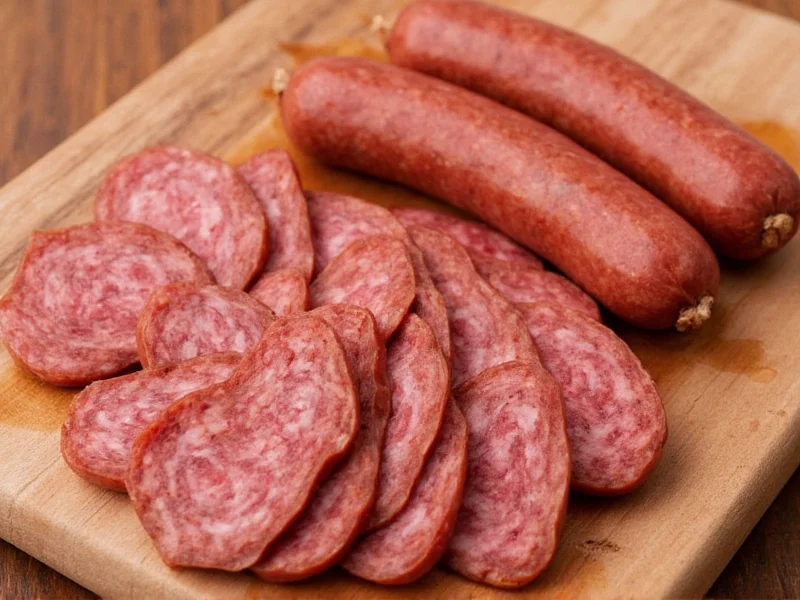Understanding the relationship between kielbasa and sausage requires recognizing that "sausage" serves as the umbrella term encompassing hundreds of varieties worldwide, while kielbasa represents one culturally specific interpretation of this versatile food. This distinction explains why grocery stores often list kielbasa alongside other sausage types rather than as a separate category.
The Sausage Spectrum: From General to Specific
Sausage production dates back to ancient civilizations as a practical method for preserving meat. The basic concept involves grinding meat, seasoning it, and encasing it for cooking or preservation. This simple formula has evolved into countless regional variations across the globe, each reflecting local ingredients, cultural preferences, and preservation techniques.
Kielbasa emerged from Polish culinary traditions as a distinctive smoked sausage typically made with pork (though traditional recipes sometimes include beef), garlic, marjoram, and other spices. Authentic Polish kielbasa undergoes specific smoking processes that contribute to its characteristic flavor profile and extended shelf life.
| Characteristic | Kielbasa | General Sausage Category |
|---|---|---|
| Classification | Specific regional variety | Broad food category |
| Primary Ingredients | Pork, garlic, marjoram, pepper | Varies by type (pork, beef, chicken, etc.) |
| Preparation Method | Typically smoked | Fresh, smoked, dried, or cooked |
| Flavor Profile | Robust garlic with subtle sweetness | Extremely variable by type |
| Geographic Origin | Poland | Worldwide variations |
Decoding Kielbasa Varieties
Traditional Polish kielbasa includes several recognized varieties, each with specific preparation methods and ingredient requirements:
- Kielbasa biała (White sausage) - Fresh, unsmoked pork sausage often prepared with milk and garlic, traditionally served with sauerkraut
- Kielbasa wiejska (Country sausage) - Coarsely ground with visible meat chunks, seasoned with pepper and marjoram
- Kielbasa myśliwska (Hunter's sausage) - Drier texture with higher garlic content, designed for longer storage
- Kielbasa krakowska - Thicker smoked sausage with distinctive flavor profile
American commercial kielbasa often differs from traditional Polish varieties, typically featuring a smoother texture and milder seasoning profile to appeal to broader palates. This adaptation explains why many consumers mistakenly believe kielbasa represents a completely separate food category rather than a specific sausage type.
Sausage Diversity Beyond Kielbasa
The sausage family includes numerous categories that differ significantly from traditional kielbasa:
- Fresh sausages like Italian sausage or breakfast sausage require cooking before consumption and have shorter shelf lives
- Dry-cured sausages such as salami undergo fermentation and drying processes without smoking
- Cooked sausages like frankfurters are fully cooked during production
- Regional specialties including Spanish chorizo, German bratwurst, and Chinese lap cheong each have distinctive ingredients and preparation methods
Practical Guidance for Cooking and Substitution
When working with kielbasa versus other sausages in recipes, consider these practical differences:
- Kielbasa's pre-cooked nature means it requires less cooking time than fresh sausages - often just heating through to preserve texture
- The robust garlic flavor of traditional kielbasa stands up well to hearty ingredients like cabbage, beans, and potatoes
- When substituting kielbasa for other smoked sausages, reduce additional garlic to avoid overpowering the dish
- For authentic Polish dishes like bigos (hunter's stew), traditional kielbasa provides the characteristic flavor profile that generic smoked sausage cannot replicate
Shopping Tips for Authentic Products
When selecting kielbasa, look for products labeled with specific Polish varieties rather than generic "kielbasa" which often indicates Americanized versions. Traditional kielbasa should list simple ingredients: pork, salt, garlic, pepper, and marjoram without excessive fillers or preservatives. The texture should be somewhat coarse with visible meat pieces rather than the uniform paste-like consistency of many commercial sausages.
For those exploring Polish cuisine, understanding the difference between kielbasa and other sausages enhances both shopping and cooking experiences. Recognizing kielbasa as a specific expression within the broader sausage tradition helps explain its unique role in Eastern European cuisine while appreciating the incredible diversity within the sausage category worldwide.
Frequently Asked Questions
Is kielbasa the same as Polish sausage?
Yes, kielbasa literally translates to "sausage" in Polish, but in English usage it specifically refers to Polish-style smoked sausage. Traditional Polish kielbasa has distinctive seasoning with garlic and marjoram, though American versions often differ from authentic Polish recipes.
Can I substitute kielbasa for other smoked sausages in recipes?
Yes, but with considerations. Kielbasa has a distinctive garlic-forward flavor profile, so when substituting in recipes, you may want to adjust additional garlic. For Polish dishes like bigos, traditional kielbasa provides authentic flavor that generic smoked sausage cannot replicate.
What makes kielbasa different from regular smoked sausage?
Traditional kielbasa differs from generic smoked sausage through its specific seasoning profile (notably garlic and marjoram), coarser meat texture, and Polish preparation methods. Authentic Polish kielbasa follows specific regional recipes, while "smoked sausage" is a broader category with more variable ingredients and preparation.
Is all kielbasa pre-cooked?
Most commercially available kielbasa in the United States is pre-cooked through smoking, making it ready to eat though typically heated before serving. However, some fresh Polish sausages labeled as kielbasa (like kielbasa biała) require cooking. Always check packaging instructions as preparation requirements vary by type.











 浙公网安备
33010002000092号
浙公网安备
33010002000092号 浙B2-20120091-4
浙B2-20120091-4